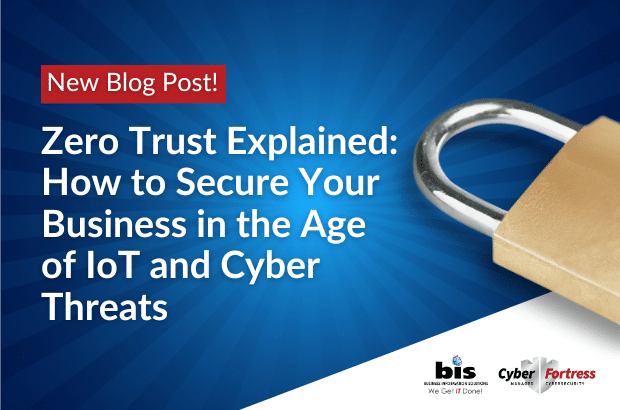“Zero Trust” is a term that has been making its rounds in the world of IT and cybersecurity for quite some time now. It’s not just a buzzword, but a cybersecurity model that can help manage risks threatening your business. In layman’s terms, it’s about setting up systems that don’t trust each other implicitly.
Nowadays, networks require more than a device being behind a secure firewall to be deemed “trusted” or secure. With the introduction of the Internet of Things (IoT), it’s made it more challenging to ensure that security. When Zero Trust is implemented correctly, any device with an IP address would be known to the firewall or Endpoint Protection (also known as antivirus).
From thermostats to smartphones, each IoT device has its own operating system with possible vulnerabilities. This means they need security patches and monitoring to ensure they haven’t been infiltrated. Adding to this complexity are users and IT staff who make decisions about what to monitor without understanding the bigger picture.
Implementing Zero Trust requires a comprehensive approach that incorporates architecture and culture of the business. Here are some tips to get started:
Do a Zero Trust Baseline Analysis
Gain clarity on the position of your business by understanding its current standing based on the number of users, the number of devices, the type of devices and the type of data you protect. It’s not a one-size-fits-all approach, and it’s best to work with a team of professionals.
Segregate Your Network
Keep business devices separate from personal devices on the network. This can be accomplished by setting up a separate WiFi for guests.
Set Up an Audit Team for Your IT Department or Provider
Make uptime and security a priority with zero trust. Since IT teams already stretched thin, this requirement flies in the face of good security. As the decision maker, you are ultimately responsible for any data breaches or downtime. Therefore, you cannot blindly trust that everything is being done properly. Instead, you should get a security audit performed by a professional who can either provide security services or hold your IT accountable.
Review Your Defense in Depth Strategy
Have a security professional review your design. A single layer of protection, like a firewall, is no longer enough to provide the protection you need. If your IT guy has issues with a review or constructive feedback, then it’s time to fire them and get someone who is willing to prioritize security.
Train Your Employees
Ensure your employees are aware of the importance of cybersecurity and how they can contribute to maintaining a secure environment. A cybersecurity program can help to accomplish this goal and keep your organization secure.
Zero Trust is a complex but critical topic that requires careful consideration and planning. It’s not a one-and-done solution, but rather an ongoing process that requires constant review and adjustment. By following these tips and working with cybersecurity professionals, you can establish a robust Zero Trust cybersecurity model that can help protect your business from online threats.
Get a Second Opinion Today!
If you’re concerned your organization doesn’t follow the zero trust model, then let’s talk! You can book a COMPLIMENTARY second opinion with Phillip. Please select a date and time from his calendar below.
ADDITIONAL RESOURCES

Phillip Long – CISSP, CEO of , along with his team of marketing and information technology experts, will walk you through an overview of what your business should be doing to protect your data and plan your digital marketing strategies.
You may reach out to us at:
Phone: 251-405-2555
Email: support@askbis.com











